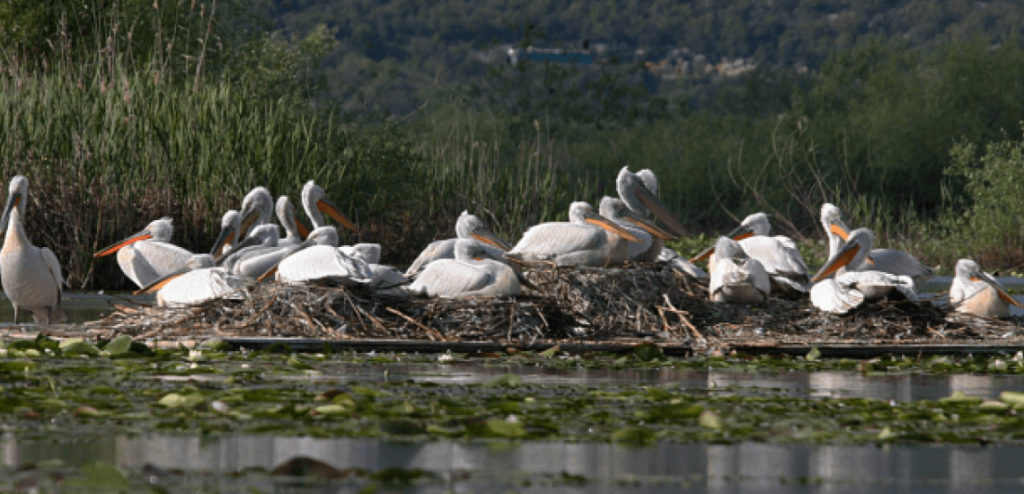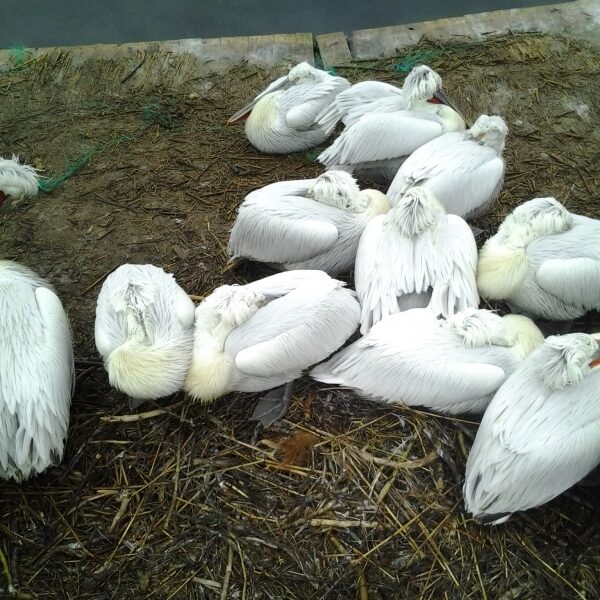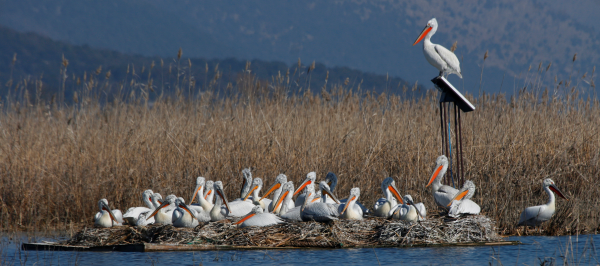Drama in Dalmatian Pelican conservation

For conservationists working to protect the remaining breeding colonies of Dalmatian Pelican on Lake Skadar in the Balkans, the fear of breeding failure is an intensely nerve-racking experience.
By Shaun Hurrell
Header image: A precious cargo of Dalmatian Pelican incubating eggs on the project’s nesting raft in 2014. Photo: Natural History Museum of Montenegro
“And then the video was gone.” Described by Bjanka Prakljacic from Noé Conservation, this moment embodies the worry and investment teams put into conservation projects across the Mediterranean.
For conservationists working to protect the remaining breeding colonies of Dalmatian Pelican on Lake Skadar in the Balkans, the fear of breeding failure is an intensely nerve-racking experience.
A floating breeding raft had been created which was very successful in 2014. Preparations had been made for the 2015 breeding season, with 300m perimeter “no-go zone” for all boats. Fishermen were coached on how to act around pelicans to prevent disturbance. Rangers and monitoring were supported. And this year live video monitoring was installed on the nesting raft to look after the pelicans newly nesting on the rafts.
But the video feed had gone dead. From a distance the project team saw empty rafts, pelicans dispersed around the lake. Thoughts rushed through their heads – why did they abandon them? Was the video system vandalized by poachers scared to be filmed? The breeding success of the entire colony was at stake.
Despite being one of world’s biggest birds, the Dalmatian Pelican is still very susceptible to disturbance. The species has been struggling and declining at Lake Skadar in Montenegro since the 1970s.
“It used to be considered bad luck to harm the noble white bird. However, direct harm is not always the only way to destroy something.”Bjanka, Project Coordinator
The species is vulnerable to flooding and human interference; and Vulnerable in IUCN Red List conservation status.
With no natural colonies breeding this year, all the eggs were in one basket – the project’s man-made nesting raft. Knowing their sensitivity to disturbance, a decision had to be made fast: go and see if the pelicans are on rafts; if not, proceed quickly to the video monitoring and try to find out what happened.
Confirmation: wires were broken/cut, wires on the solar panel powering the camera were bent…
Dalmatian Pelican Pelecanus crispus have a rich history at Lake Skadar. Nestled between Montenegro and Albania, Lake Skadar is one of the largest bird reserves in Europe, but also a center for human activity. As an enduring symbol of the largest freshwater lake in the Balkans, the giant white bird can still be seen flying over the vast blue waters. Tending towards Endangered though, the time came to do something to save it.
In November 2013, there was an interesting gathering in a meeting hall of the National Park Skadar Lake building. Over a sign ‘Restaurant Pelican’ a small window viewed people arriving from across Europe to discuss the start of the project Conservation of Pelicans, a Key Biodiversity Species of Skadar Lake, funded by the Critical Ecosystem Partnership Fund (CEPF). It was there that they reached the first major conclusion:

“The solution must be a joined one!”
Noé Conservation coordinated the big collaborative project involving 7 other organisations including the local BirdLife Partner, CZIP (Center for Protection and Research of Birds in Montenegro).
The project aims to protect the colony and improve breeding success, with patrols by National Park guards, and floating nest platforms to reduce the impact of water level changes. Being an icon for the Lake Skadar, pelican-friendly tourism (Pelican Villages) promotes the natural heritage of the entire lake, supported also by environmental education campaigns. The project also brings new practices in monitoring and research, and supports local institutions towards the main goal of a rich and stable pelican population.
Back to the action. The monitoring team (Natural History Museum of Montenegro) could repair the damage to the video equipment on site, and they soon backed out. Pelicans returned to the rafts in less than 30 minutes. But the team could also see the remains of eggs broken by magpies and licked clean. The pelicans were scared away during the incident with the wire for too long, and the first eggs were dead.
But then the activity picked up again. The project focused on decreasing disturbance; more pelicans returned.
“It was almost unbelievable to see days and days of complete peace on the rafts, and before the middle of January, new eggs could be seen,” said Bjanka.
“It was unnerving to watch them, so far away, day after day, on their eggs. Knowing that at each moment a disaster can strike.”Bjanka Prakljacic, Project Coordinator.
Then the video went off again.
Frustration, anger and even tears were present throughout the project team that day. All they could do was wait for the report from the monitoring team. Meanwhile, thoughts spread through the wary team: Do we take the video monitoring down? Is it because of the video monitoring that another nesting attempt is lost? Is our work with rangers and fishermen in vain?
Then there was the phone call: “Rafts are packed with pelicans. Pelicans are all there undisturbed, we could not go to the video equipment as pelicans are there. There is even one on the wires on the solar panel – it has been bending the wires all along!”
The reason for stop in the original video monitoring is not yet fully determined, but the team can breathe a sigh of relief that the pelicans are fine.
This year the commitment of the teams working to protect them had paid off, and the pelicans on Lake Skadar had a successful breeding season.
The project continues to build awareness and ecotourism around Lake Skadar to ensure the protection of these sensitive pelicans well after the project ends.

“You can invest all your energy into working, but at the end of the day, it is up to the locals to protect the pelicans in the future”Bjanka Prakljacic, Project Coordinator.
Dalmatian Pelican Project highlights from Lake Skadar:
- ‘The CEPF project meeting’ November 2013. Then the team moved fast.
- Specially designed raft set up just days before start of nesting season Dec 2013.
- Natural colonies faced losses due to floods, eggs floating in water. Pelicans start colony on project’s rafts March 2014.
- June 2014: an incredible result! Confirmation of best breeding season for Dalmatian Pelican for 36 years: 48 chicks from 70 adults!
- Still some human disturbance affecting the sensitive pelicans, but collaborative project proves change can be made through equipment, education, promotion, ecotourism.
- Dec 2014 lots of nest building activity again: “It is truly amazing how those big beaks can move so gently and controlled to place a reed stalk in the growing nest.”
- The video monitoring drama described above!
- 2015 breeding success

The Critical Ecosystem Partnership Fund (CEPF) is a joint initiative of l’Agence Française de Développement (AFD), Conservation International (CI), the European Union, the Global Environment Facility (GEF), the Government of Japan, the John D. and Catherine T. MacArthur Foundation, and the World Bank. Additional support in the Mediterranean Basin is provided by the MAVA Foundation. A fundamental goal is to ensure civil society is engaged in biodiversity conservation.

BirdLife International – including its Middle East office and the BirdLife Partners DOPPS/BirdLife Slovenia and LPO (Ligue pour la Protection des Oiseaux, BirdLife in France) – is providing the Regional Implementation Team (RIT) for the Critical Ecosystem Partnership Fund (CEPF) in the Mediterranean Basin Biodiversity Hotspot (CEPF Med). Find out more at www.birdlife.org/cepf-med.
CEPF project title: Conservation of Pelicans, a Key Biodiversity Species of Skadar Lake

Grantee: Noé Conservation. Partners: Public Enterprise National Parks of Montenegro; National Park Skadar Lake; Natural History Museum of Montenegro; CZIP – Center for Protection and Research of Birds of Montenegro; Tour du Valat; EuroNature; Association for the Protection of Aquatic Wildlife Albania.
This CEPF project is part of – and complimented by – a wider project, funded by the MAVA Foundation, called “Wetland Management and Dalmatian Pelican Conservation in the Mediterranean Basin” covering Albania (Karavasta), Greece (Kerkini Lake) and Montenegro (Skadar Lake).